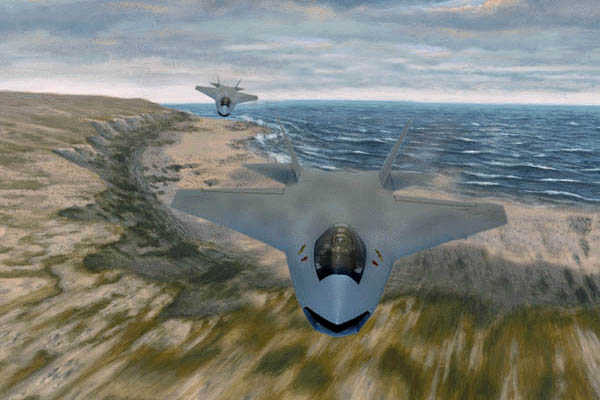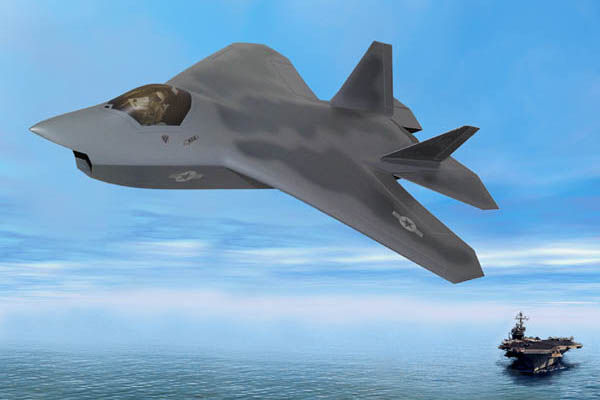
JSF Facts
In November, 1996, the Department of Defense awarded The Boeing Company a 51-month contract to proceed with the Joint Strike Fighter Concept Demonstration Program. The award, announced by Secretary of Defense William Perry, culminated an effort begun two decades ago with the goal of returning Boeing to the ranks of fighter aircraft manufacturers.

With its innovative design validated by more than 18,000 hours of aggressive simulation and testing, Boeing has developed an affordable strike aircraft concept to meet the post-2000 needs of the U.S. Air Force, Navy, Marines and U.S. allies.

From the outset, Boeing has focused its Joint Strike Fighter (JSF) design concept on the need for the aircraft to be affordable and to meet multi-service requirements.

Boeing incorporates affordability into its Joint Strike Fighter by identifying the common design space of each service variant. Then, using a modular approach to the design, Boeing has developed specific variants to meet the unique requirements of each service. Because this approach generates such high part commonality among all the service variants, they can be assembled on a single production line resulting in lower unit cost.

The Boeing JSF design exploits experience in modern composite materials and manufacturing processes gained in the commercial 777 jetliner, the B-2 bomber and the F-22 air dominance fighter. The unique expertise accrued in these key technologies significantly contributes to the light weight and low cost of the Boeing JSF concept.

Although the Boeing concept stresses affordability, it does not sacrifice performance fundamental to mission effectiveness. The Boeing JSF has maneuver capabilities equal to or better than the F-16 and F/A-18 and a combat radius and payload significantly better than the F-16 and F/A-18. Recognizing the need to validate its innovative JSF design concept concurrent with engineering and program milestones, Boeing conducted an unprecedented series of simulations and tests of its JSF design.

By the summer of 1996 when Boeing submitted its JSF proposal to the customer, Boeing had completed more than 11,800 hours of highly successful JSF-related tests in facilities on two continents. Some of the major areas of the JSF test program included:
The RCS tests were so successful that Boeing needed only a few hours to validate the design instead of the weeks originally scheduled to match results with detailed pre-test predictions. The radar range tests strongly validated not only Boeing's unique design but its basic analysis and test methodology as well.
The JSF Program Office (formerly the Joint Advanced Strike Technology Program) based in Washington, D.C. in early 1996, issued its Request For Proposals (RFP) for the concept demonstration phase of the program that will lead to the building of approximately 3,000 Joint Strike Fighters in the next century.
The U.S. Air Force needs a low-cost, multi-role fighter to replace the F-16 and A-10 as they age in the early years of the 21st century. The U.S. Navy needs a first-day-of-the-war survivable strike aircraft. This aircraft must possess capabilities suitable to replace the A-6 which has already left the inventory. The U.S. Marine Corps needs a Short Takeoff/Vertical Landing (STOVL) aircraft to replace its AV-8B and F/A-18. The Marine Corps wants to transition to an all-STOVL strike force early in the 21st century. The United Kingdom Royal Navy needs a STOVL aircraft to replace its aging Sea Harrier.
For the Marine Corps and the UK Royal Navy JSF variant, Boeing selected a direct-lift STOVL configuration because of its light weight and proven application on the AV-8B Harrier. This simple concept has the least impact on the basic airframe structure, better lends itself to a common modular approach for all four services, and is the lowest cost solution.
The Boeing JSF concept not only meets the UK Harrier replacement needs, but may meet the requirements for the UK Future Offensive Aircraft (FOA) as well. Other allies have voiced interest in the JSF program and Boeing believes there will be a substantial international market for the low-cost, high-performance strike aircraft.
DESIGN/PERFORMANCE:
BOEING JSF WORKFORCE:
|
